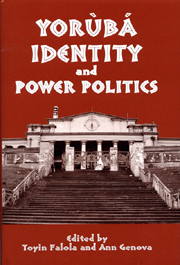Book contents
- Frontmatter
- Contents
- List of Illustrations
- Introduction
- Part I Writing Yorùbá
- 1 The Yorùbá Nation
- 2 Oral Tradition and the Reconstruction of Yorùbá Dress
- 3 Diaries as Cultural and Intellectual Histories
- 4 Historiography of Western Yorùbá Borderlands
- 5 The History of the Okun Yorùbá: Research Directions
- 6 Ìlá Kingdom Revisited: Recent Archaeological Research at Ìlá-Yàrà
- 7 Early Ìjѐbú History: An Analysis on Demographic Evolution and State Formation
- Part II Chiefs and Tradition
- Part III Identity and Modern Politics
- Notes on the Contributors
- Index
1 - The Yorùbá Nation
from Part I - Writing Yorùbá
Published online by Cambridge University Press: 12 September 2012
- Frontmatter
- Contents
- List of Illustrations
- Introduction
- Part I Writing Yorùbá
- 1 The Yorùbá Nation
- 2 Oral Tradition and the Reconstruction of Yorùbá Dress
- 3 Diaries as Cultural and Intellectual Histories
- 4 Historiography of Western Yorùbá Borderlands
- 5 The History of the Okun Yorùbá: Research Directions
- 6 Ìlá Kingdom Revisited: Recent Archaeological Research at Ìlá-Yàrà
- 7 Early Ìjѐbú History: An Analysis on Demographic Evolution and State Formation
- Part II Chiefs and Tradition
- Part III Identity and Modern Politics
- Notes on the Contributors
- Index
Summary
The “Nation” and Its People
The modern map consigns the Yorùbá to the southwestern part of Nigeria, a product of colonial creation reflecting the limitations of maps and the European origins of the modern nation state in Africa. This specific location does not capture the historical geography of the Yorùbá-speaking people, although it has had a substantial impact on how knowledge about them has been constituted. The map is true in the sense that the majority of the Yorùbá population now lives in southwestern Nigeria. It is incomplete because the colonial map does not include the entire “home” of the Yorùbá in West Africa and the African diaspora.
As the Yorùbá entered the map of the first half of the twentieth century, they were mainly lumped in what was known for many years as “Western Nigeria.” The configuration of their identity also reflected this map, especially after the 1940s when political parties were formed. The Yorùbá regarded the Western Region as theirs, thus merging ethnic and regional identities as one. To the south of this map is a coast, followed by a dense equatorial forest that stretched west for about fifty miles, and also broadening eastward. And there is the savanna to the north. Using a linguistic definition, the Yorùbá are located within the long stretch of the river Niger in the east and the river Mono in the west, which is bigger than the representation in the modern map.
- Type
- Chapter
- Information
- Yorùbá Identity and Power Politics , pp. 29 - 48Publisher: Boydell & BrewerPrint publication year: 2006

